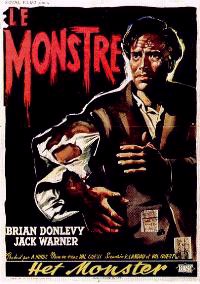

![]()
| (1955) Black and White, 78 minutes, Not Rated
Cast: Brian Donlevy (Quatermass), Jack Warner (Lomax), Margia Dean (Judith), Richard Wordsworth (Caroon), David King Wood (Briscoe), Thora Hird (Rosie), Gordon Jackson (Producer), Harold Lang (Christie), Lionel Jeffries (Blake), Maurice Kauffman (Marsh), Gron Davies (Green), Stanley Van Beers (Reichheim), Frank Phillips (BBC Announcer), Arthur Love (Sgt. Bromley), John Stirling (Major), Eric Corrie (Young Man), Margaret Anderson (Maggie), Henry Longhurst (Maggie's Father), Michael Godfrey (Fireman), Fred Johnson (Inspector), George Roderick (Policeman), Ernest Hare (Fire Chief), John Kerr (Lab Assistant), John Wynn (Best), Toke Townley (Chemist), Bartlett Mullins (Zoo Keeper), Molly Glessing (Mother At Zoo), Mayne Lynton (Zoo Official), Harry Brunsing (Night Porter), Barry Lowe (Tucker), Jane Aird (Mrs. Lomax), Sam Kydd (Station Sergeant), Arthur Gross (Floor Boy), James Drake (Sound Engineer), Edward Dane (Policeman), Basil Dignam (Sir Lionel), Betty Imprey (Nurse), Marianne Stone (Nurse) CREDITS: Director: Val Guest; Producer: Anthony Hinds; Screenplay: Val Guest, Richard Landau based on the Nigel Kneale BBC production; Director of Photgraphy: Walter Harvey; Music: James Bernard; Music Supervisor: John Hollingsworth; Art DIrector: J. Elder Wills; Production Manager: T.S. Lyndon-Hayes; Editor: James Needs; Special Effects: Les Bowie; Sound Recordist: H.C. Pearson; Continuity: Renee Glynn; Hairstyles: Monica Hustler; Makeup: Phil Leakey; Camera Operator: Len Harris; Assistant Director: Bill Shore |

|
![]()
After a rocketship crashes in the English countryside, Professor Quatermass arrives to survey the damage and see if there are any survivors. Of the three scientist/astronauts who manned the spacecraft (Green, Reichenheim and Caroon), only Caroon survives. Not only is he the only survivor, but the other two have disappeared without a trace. Caroon is taken back to the rocket base where he is placed under Quatermass's supervision and an investigation is launched. They discover that film footage has also survived the crash and when it's developed they reach the conclusion that some alien lifeform affected the men. Meanwhile, Caroon has begun to change. He body is mutating into something unknown to the earth's scientists.
Caroon's wife Judith doesn't trust the British officials so she hires a private investigator to sneak in and help her husband escape. Caroon is longer control by his human nature, and the alien virus in him begins to spread as his hand begins conforming to a cactus plant Caroon had destroyed. Caroon kills the private investigator in his escape and Judith realizes that she has made a grave error.
Caroon soon reaches a totally inhuman, tentacled form and begins absorbing all life it comes in contact with. The Caroon/creature hides in Westminster Abbey but is soon discovered by a film crew. Learning that electricity can stop and possible kill the creature, Quatermass diverts the power supply into the creature, destroying it but not stopping the British space program as Quatermass returns to the base to start again.
![]()
THE QUATERMASS XPERIMENT originally appeared as a six-part serial broadcast on the BBC running at two hundred minutes. The extreme popularity of the show made it a natural project to be developed into a feature film. The 1950's produced an movie-going audience who became obsessed with science fiction films, especially if it involved monsters. Val Guest and Richard Landau began the monumental task of cutting down the lengthy broadcast into a feature film, much to the distaste of it's original writer Nigel Kneale. Still, the basic concept is in tact and THE QUATERMASS XPERIMENT proved to be a success.
Much has been written about Brian Donlevy's appearance in the film. Hammer wanted an American actor to appeal to the U.S. audiences. He does a fine straightforward job in the role, although it was reported that he didn't fare well with his co-stars because of a drinking problem. Val Guest, who directed the film, felt that Donlevy was a professional even though he occasionally showed up with signs of drinking but that it never affected his performance.
When Val Guest began directing the film on October 18, 1954, he decided to use a cinema-verite style of directing because he wanted to make the film have a sort of documentary look almost as though it had been filmed by a news crew. The style worked and helped to bring an amount of believability to the film.
It's important to note that this was James Bernard's first film score and it quite effectively captures the mood and feel of the film. Bernard would go one to write some of the best scores for Hammer and this was an excellent indication of the direction he would follow when scoring films.
THE QUATERMASS XPERIMENT was presented at a trade show on August 25, 1955 and then went into general release on September 5. Knowing that the film would get a X Certificate from British censors, the E was dropped from Experiment to emphasis the horror angle of the film. It was originally packaged as a double feature with RIFIFI and then later went out paired with the Hammer featurette THE ERIC WINSTON SHOW BAND.
Overall, the critics and the public received the film very well giving it good notices. It was released in the United States as THE CREEPING UNKNOWN and it was rumored that a young boy died of fright at a screening in Rockport Illinois. That rumor has never been confirmed, but it's never been proven not to be true as well. Combining science fiction with horror elements proved to be to successful for Hammer to pass up on and they began tailoring the films to represent that image. Their next horror related feature was X-THE UNKNOWN.
![]()
| Home | Features | Short Subjects | Autographs | Equipment |